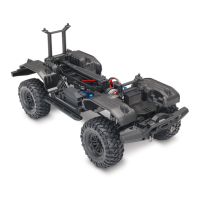
Do you have a question about the Traxxas TRX4 SPORT 82024-4 and is the answer not in the manual?
| Brand | Traxxas |
|---|---|
| Model | TRX4 SPORT 82024-4 |
| Category | Motorized Toy Car |
| Language | English |
Traxxas support is with you every step of the way. Refer to the next page for contact info and support options.
Manual's Quick Start path outlines procedures to get your model running quickly.
Register your product within 10 days of purchase online at Traxxas.com/register for better service.
Device compliance with FCC limits for Class B digital devices.
Contact Traxxas Technical Support toll-free for questions about your model or its operation.
Identifies warnings and helpful hints throughout the manual using specific icons.
Key points to remember for safe operation, including avoiding public roads and crowds.
Precautions for the powerful electronic speed control to prevent damage or injury.
Encourages recycling of Traxxas Power Cell NiMH batteries at the end of their life.
Critical warnings about LiPo battery fire hazards, requiring special care and handling.
Essential precautions for LiPo battery usage, including discharge thresholds and charging.
Safety guidelines for charging all battery types, emphasizing correct settings and handling.
Lists the specialty metric tools included with your model.
Lists essential items needed to operate and maintain your model.
Lists optional but recommended tools for any R/C toolbox.
Diagram showing the top view of the TRX-4 Sport chassis with labeled components.
Diagram showing the bottom view of the TRX-4 Sport chassis with labeled components.
Review safety precautions on page 4 to understand risks and prevent injury.
Install 4 AA alkaline batteries into the transmitter as described on page 14.
Charge your model's battery pack using a compatible charger (not included).
Install a fully charged battery pack into the model as detailed on page 15.
Turn the transmitter on first and off last as a safety habit.
Verify that the steering servos are functioning correctly.
Perform a range test to ensure radio system works at a distance.
Apply any desired additional decals to your model.
Follow driving tips and adjustments for your model on page 22.
Follow critical steps on page 30 to maintain model performance.
Overview of the TQ 2.4GHz transmitter, its automatic frequency selection, and basic operation.
Definitions of key terms related to radio and power systems used in the manual.
Instructions and tips for applying additional decals to the model.
Explanation of the ESC's thermal shutdown feature to prevent overheating.
Description of the 2-channel system, 2.4GHz Spread Spectrum, and Voltage.
Key precautions for the receiver antenna wire to maintain optimal radio range.
Details on the transmitter controls and receiver functions for the TQ 2.4GHz system.
Diagram illustrating the wiring connections for the model's radio system.
Diagram showing the specific wiring of the XL-5 HV ESC to the motor and battery.
Guide to installing 4 AA batteries in the transmitter for power.
Recommendations for compatible LiPo/NiMH batteries and Traxxas EZ-Peak chargers.
Critical warnings for LiPo battery users regarding fire hazards and necessary precautions.
Instructions for installing the battery pack, including wire management.
Explanation of the benefits of the Traxxas High-Current Connector for power delivery.
Procedure for securing the model's body to the chassis.
Instructions for properly installing the receiver antenna tube and wire.
Details on the Battery iD feature for automatic charger recognition and optimal charging.
Overview of the transmitter's controls and their functions.
Essential rules for safe radio system operation, including power-on/off sequence.
Instructions for adjusting steering trim and reversing servo channels.
Steps to check radio system operation, including steering, throttle, and trim.
Procedure to ensure the radio system operates properly at a distance.
Explanation of the safety feature preventing unintended acceleration.
Explanation of the built-in fail-safe that returns throttle to neutral on signal loss.
Steps to re-bind the transmitter and receiver if needed.
Chart explaining the meaning of transmitter LED indicators.
Chart explaining the meaning of receiver LED indicators.
Setting and verifying Low-Voltage Detection for LiPo batteries to prevent over-discharge.
Step-by-step guide to calibrate the ESC and transmitter for proper control.
Instructions for operating the ESC, including disabling Low-Voltage Detection for NiMH batteries.
Technical specifications for the XL-5 HV electronic speed control.
Explanation of Training Mode (Profile #3) for reduced throttle control for beginners.
Instructions for quickly switching between ESC profiles like Sport and Training.
Guide to selecting different ESC operating profiles: Sport, Race, Trail, and Crawl.
Instructions to configure the ESC for Sport Mode (100% Forward, Brakes, Reverse).
Instructions to configure the ESC for Race Mode (100% Forward, Brakes, No Reverse).
Instructions to configure the ESC for Training Mode (50% Forward, Brakes, 50% Reverse).
Instructions to configure the ESC for Trail Mode (100% Forward, Brakes, Drag Brake).
Instructions to configure the ESC for Crawl Mode (Hill Hold Brakes, Immediate Reverse).
Critical warning against using LiPo batteries with Low-Voltage Detection disabled.
Explanation of ESC LED indicators for Over-temp, Low-Voltage, Over-voltage, and No Signal.
Description of the ESC's safety feature to prevent unintended acceleration.
Factors affecting battery run time, including capacity and driving habits.
Advice on maximizing battery performance and operational duration.
Information on the model's water-resistant features and requirements for wet operation.
Essential precautions for operating the model in wet conditions and maintenance responsibilities.
Specific advice for the Titan 550 motor regarding operation in mud and water.
Necessary preparations and checks before running the model in wet environments.
Detailed procedures for cleaning and maintaining the model after wet operation.
Increased maintenance frequency for components after extended wet use.
Maintenance for portal gearboxes, transmission, and motor.
Instructions for removing and installing the receiver while keeping the box watertight.
Step-by-step guide for extracting the receiver from its box.
Step-by-step guide for installing the receiver back into its box.
Details on suspension springs and how body weight affects selection.
How to adjust the model's ride height by threading shock preload adjusters.
Explanation of shock oil viscosity and its effect on damping.
Instructions for draining and refilling shock oil.
Steps for taking apart the shocks for maintenance or repair.
Instructions for reassembling shocks after servicing.
Procedure for adjusting the slipper clutch for drivetrain protection.
Considerations for selecting aftermarket wheels and tires.
Information on the Titan 550 motor and optimizing gear ratios.
Chart detailing gear combinations for various performance characteristics.
How to set the correct gear mesh for the spur and pinion gears.
Steps for removing and installing the motor assembly.
How to adjust the steering system linkage for proper alignment.
Guidance on fitting aftermarket bodies, focusing on rear shock tower placement.
Checklist for inspecting the vehicle for damage, wear, and loose parts.
Covers periodic maintenance for slipper clutch, chassis, motor, shocks, suspension, and driveline.
Guidelines for storing the model, including battery removal.











